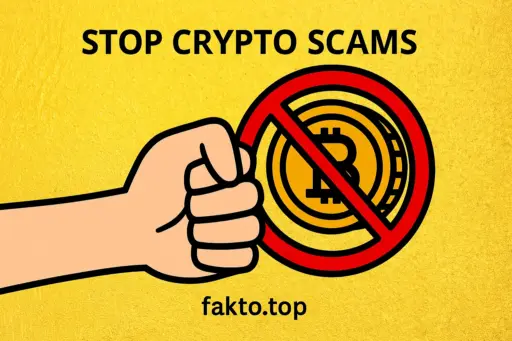Crypto Scams in the US: Red Flags, Security Guide & How to Secure Your Wallet
Stop Losing Money: Top U.S. Cryptocurrency Scams, Warning Signs, and How to Protect Your Wallet
Cryptocurrency scams are becoming increasingly sophisticated every year. Scammers exploit trust, curiosity, and greed by creating fake apps, websites, and social media accounts to steal funds. Early detection of the signs and understanding the tactics of these scams is crucial to protect your assets. In this comprehensive guide, we cover the most dangerous types of cryptocurrency scams, explain how scammers manipulate victims, and provide detailed, actionable steps to effectively safeguard your assets.
5 Most Common Cryptocurrency Scams
1. Pig Butchering Scam
The Pig Butchering scam, known as ‘Sha Zhu Pan,’ is a long-term scheme designed to build trust before theft. Scammers initiate contact via messaging apps, dating platforms, or social media, maintaining seemingly innocent conversations for weeks or months. They then gradually introduce fake investment tips and fabricated portfolio screenshots of massive success.
Once the victim’s trust is fully established, the scammer pushes them to deposit funds into a fake trading platform or mobile app designed to look legitimate but is entirely controlled by the fraudsters. Victims are encouraged to deposit more funds to chase fabricated profits, which are then stolen entirely in one swift move. The psychological tactic relies on gradually ‘fattening’ the victim’s confidence, making sudden losses feel like an unfortunate market event rather than outright theft.

A typical interaction evolves subtly, moving from casual chat to high-pressure investment:
Scammer: I noticed your profile. I’ve been using this private app for a month and doubled my BTC, want me to show you the profits?
Victim: Sure, sounds interesting.
Scammer: Here’s the download link. Don’t worry, it’s fully secure and verified by my finance team.
Victim: Looks convincing. How does it work?
Scammer: Very simple. You deposit a small amount to activate the trading bot. After that, the system trades automatically and generates daily returns.
Victim: Sounds promising, do you really think I can earn from this?
Scammer: Absolutely. Everyone who joined in the last few weeks has already seen massive growth. You don’t want to miss this chance while Bitcoin is rising fast.
The fake app interface often mimics real exchanges, showing portfolio balances that increase artificially by 10% or more daily. When the victim attempts to withdraw the “profit,” they are hit with massive “fees” or “taxation” demands, compelling them to deposit even more funds before the scammer eventually disappears with the entire principal.

2. Rug Pulls and Fake DeFi Projects
Rug pulls occur when the anonymous developers of a new token or Decentralized Finance (DeFi) project collect investments, often through initial coin offerings (ICOs) or providing liquidity, then abruptly drain the liquidity pool. This leaves investors with tokens that instantly become worthless. Scammers create hype through aggressive social media marketing, fake community engagement, and fabricated developer roadmaps. They exploit FOMO (Fear of Missing Out), promising extremely high returns (e.g., 1000% Annual Percentage Yield, APY) that are clearly unsustainable.
To avoid these devastating scams, check the project’s smart contract on explorers like Etherscan, review its official audit reports (ensuring they are from reputable third parties, not just a PDF linked on their website), and examine developer activity. Look for fully anonymous teams, unrealistic promises, or contracts that contain ‘minting’ or ‘owner’ functions allowing the developer to control the supply or lock liquidity. A legitimate project typically has an active GitHub repository, verifiable core team members, and a clear, sustainable business model, not just inflated returns.
3. Phishing Attacks
Phishing is a social engineering attack designed to steal login credentials, private keys, or the seed phrase. Scammers may use highly deceptive emails, SMS messages, fake websites, or pop-ups that look identical to official platforms like Coinbase or MetaMask. These messages often create urgency, claiming an account suspension or an unauthorized login requires immediate verification.
Common tricks used to bypass visual inspection include:
- Homoglyph Swapping: Replacing letters with visually similar characters, such as replacing ‘l’ (lowercase L) with ‘1’ (the number one) (example: coinb1ase.com instead of coinbase.com).
- Hyphenation: Adding hyphens to legitimate domains (example: coin-base.com).
- Typosquatting: Using common typos or misspellings that users often make (example: binance.info instead of binance.com).
Always manually type official website addresses and avoid clicking links in unsolicited messages. Never enter your seed phrase on any online form, pop-up, or third-party site; legitimate services will never ask for it. Using strong password managers and anti-phishing codes (where offered by exchanges) adds a mandatory layer of protection against these common deceptive tactics.

4. Impersonation and Support Scams
Scammers frequently pose as platform support agents (e.g., Ledger support, MetaMask team) or influential figures in crypto communities. They contact victims through direct messages on Telegram, Discord, or X (Twitter), or even via cold phone calls, claiming urgent action is needed to secure accounts due to a “bug” or “security alert.” Their goal is always to obtain private keys or the seed phrase. Tactics include initiating a “fake verification process,” creating urgency, or threatening immediate account suspension.
Remember this absolute rule: Genuine support will never ask for your private keys or seed phrases. Always confirm the identity of anyone contacting you by reaching out directly through the official, verified customer support portal (via their website), not through a link or contact provided in the unsolicited message. Avoid downloading remote desktop software (like AnyDesk or TeamViewer) suggested by anyone you haven’t personally verified through official channels.
5. Giveaway and Influencer Scams
Fake Giveaway and Influencer Scams capitalize on trust and the promise of easy money. These promotions often appear on social media platforms, hosted by accounts that perfectly mimic or are paid to promote from high-profile celebrities or crypto influencers. These scams usually promise to “double your crypto” (e.g., “Send 0.1 ETH and receive 0.2 ETH back immediately”) if you send a small amount first to a specified wallet address. The tactic exploits trust in public figures and the fear of missing out on a huge opportunity.
Before participating, verify sources carefully: check the account’s verification status, examine their prior post history for inconsistency, and search for prior reports of the same scam format. Legitimate giveaways do not require deposits; if you are asked to send crypto upfront to claim a prize, it is a scam 100% of the time. Protect your funds by avoiding any promotion that requires you to send money first.
Essential Crypto Security Measures: How to Secure Your Wallet
Choosing Your Fortress: Best Hardware Wallets for Security
Hardware wallets provide the highest level of security by ensuring your private keys are generated and stored entirely offline, making them immune to online malware and phishing attacks. Popular and trusted options include Ledger and Trezor. Always purchase your device exclusively from the official manufacturer’s website or a certified distributor to avoid potentially tampered devices. Steps for securing your wallet properly:
- Purchase Directly: Buy only from the official brand’s website to prevent supply chain attacks.
- Initialize Offline: Set up the device in a secure, offline environment, writing down your recovery phrase physically.
- Generate Strong Passcode: Use a unique and complex PIN for the device.
- Secure Backup: Store the recovery phrase (the 12/24 words) in a secure, fireproof, and separate location from the hardware device itself.
- Advanced Use: Consider using multi-signature wallets (Multi-sig) for added security on extremely large holdings, requiring multiple keys for any transaction.
Vetting a New Crypto Project: The 5-Point Audit
Before investing in any new token, DeFi platform, or NFT collection, perform this essential 5-Point Audit to uncover common red flags:
- Team Transparency: Verify the development team’s credibility. If the entire team is anonymous (a common feature in rug pulls), consider it an extremely high risk. Search their LinkedIn profiles or confirmed credentials.
- Smart Contract Audits: Review the contract; look for publicly available and verified audits from reputable third-party security firms (e.g., CertiK, PeckShield). A project without an audit is highly risky.
- Community Sentiment: Check the project’s community activity across Discord, Telegram, and X. Look for realistic, technical discussions, rather than simple hype and unrealistic returns. Be wary of channels with heavy bot activity or excessive moderation.
- Tokenomics Analysis: study the distribution model. Pay attention to large holdings controlled by a single wallet or sudden, unannounced transfers from developer wallets. Unrealistic yields or unstable incentives indicate unsustainable models.
- External Review: examine external analyses, major news coverage, and specialized fraud reports to uncover any previous history of scams or serious security vulnerabilities.
Beyond Passwords: Implementing Multi-Factor Authentication and Anti-Phishing Codes
Passwords alone are not enough to protect against sophisticated phishing attacks and hacks. Multi-factor authentication (MFA) is mandatory for all crypto accounts (exchanges, wallets, and primary email addresses). Account security measures:
- Enable Hardware Keys (Priority): use security hardware keys (e.g., YubiKey) for the most reliable form of MFA.
- App-Based Two-Factor Authentication: use apps with time-based one-time passwords (TOTP) like Google Authenticator or Authy instead of SMS-based 2FA, which is vulnerable to SIM swap attacks.
- Anti-Phishing Codes: set up anti-phishing codes offered by major exchanges (e.g., Coinbase or Kraken). This code appears in genuine emails from the exchange, confirming authenticity and preventing fraud.
- Regular Monitoring: regularly review login activity and revoke access for unknown or unused devices.
Advanced Protection Strategies: New Ways to Safeguard Crypto Assets
Burn Wallet Strategy: Using a Zero-Balance Wallet for Interactions
The disposable wallet strategy is one of the most effective ways to separate and minimize risk. This is a secondary, sacrificial wallet with minimal funds (just enough to cover transaction fees), used solely for interacting with new tokens, minting NFTs, or connecting to unknown decentralized applications (DApps). If the disposable wallet is compromised by a malicious contract or phishing link, your primary assets remain safe offline. Steps to implement this strategy:

- Create a dedicated wallet separate from your main hardware wallet.
- Transfer only small amounts (minimum needed for a transaction or mint) that you are willing to lose.
- Use this wallet exclusively for new platforms or experimental interactions.
- Important: never link your main hardware wallet or long-term assets to this wallet.
- Regularly monitor its activity and, if possible, reset funds after use.
Zero Tolerance for Signatures: Not All Signs Are Good Signs
Here’s a professional security cheat code: most beginners look only at the transaction amount (“Okay, I’m paying $5 for gas, all good”). But real scammers hide in the metadata — the actual contract you’re signing.
It’s like being handed a document where the fine print says: “I authorize you to take all my funds at any time.” That’s why you need a “Zero-Tolerance Signing Policy.” When you see a “Sign” or “Approve” button in your wallet, don’t click it like a “Like” button on TikTok!
Use the “Human-Readable Breakdown” feature in your wallet (e.g., Ledger Live or some extensions) to see what you are actually approving. Beware of standard “Sign Message” requests; these often grant control over a specific token or full access to drain your wallet (Unlimited Spend Approval).
If you do not fully understand what the signature entails, click “REJECT” and close. Your signature is your digital contract. Better paranoid and wealthy than relaxed and broke.
Prevent Clipboard Hijacking: Manually Verify Every Address
Clipboard hijacking is a subtle but extremely dangerous threat. Malware on your computer monitors the clipboard and silently replaces the address you copied (e.g., a friend’s wallet) with a scammer’s address just before you paste it into the transaction field. To protect yourself, make it a rule to manually verify every address before confirming a transaction:
- 4/4 Rule: After pasting an address, always visually check the first four and last four characters to ensure they match the intended recipient.
- Test Transactions: for large transactions, first send a very small test amount to ensure it arrives correctly.
- Browser Tools: consider using browser extensions or specialized crypto wallets that provide visual alerts if the copied address differs from the clipboard.
- Slow Verification: develop a habit of slow, deliberate checking; rushing or overconfidence can lead to irreversible losses.
Etherscan and Contract Audit Habit: Quick Checks Before Investing
Before signing a transaction or investing in new tokens, checking the basic smart contract on a block explorer like Etherscan (for Ethereum and EVM chains) is a crucial step. This ensures transparency and prevents malicious functionality. Follow these steps for a quick check:
- Contract Verification Status: look for a green checkmark next to the contract address on Etherscan, indicating the code is verified and published.
- Check for Audit Report Links: on the contract page, look for links to reputable third-party audit reports. If none exist, proceed with extreme caution.
- Token Holders Tab: Check the token distribution. If one wallet holds 80-90% of the supply, it indicates extreme centralization and a high rug pull risk.
- Developer Control: Look for unusual functions (like selfDestruct() or setOwner()) that may allow developers to drain liquidity or halt trading.
- Community/Sentiment Check: Combine Etherscan checks with community sentiment analysis to ensure the project is actively maintained.
Extra Layer: Separation of Funds
Look, the easiest way to not freak out if stuff goes south is to not keep all your crypto in one basket. Spread it out. Keep your long-term stash in a cold wallet — that’s like your vault. Use a separate software wallet for day-to-day trading. And make a tiny “burner” wallet for testing new apps or sketchy coins. If one thing gets hacked, the rest stays safe. Simple, right?
I Got Scammed: Now What?
Step 1: Reporting the Scam
Okay, first, breathe. Yeah, it sucks, but you gotta act fast. Gather everything: TX IDs, wallet addresses, timestamps, screenshots — all the receipts. This stuff is gold for investigators.
Hit up official channels:
Step 2: Stop the Bleeding
Do these ASAP:
- Freeze your exchange accounts, change passwords — now.
- Reset MFA with a fresh security key or app.
- Tell your wallet/exchange support what happened.
- Keep an eye on the scammer’s address — sometimes you can spot secondary moves.
- Warn the community, don’t let someone else trip over the same trap.
Step 3: Lessons Learned
Crypto isn’t like a bank, most TXs are final. You might not get it back. But report it anyway — helps cops and future victims. Look back and ask: did I check addresses? Use a burner wallet? Fix the weak points for next time.
Long-Term Safety Tips
Layer Your Security
Don’t rely on one thing. Mix it up: cold wallets, burner wallets, MFA, check smart contracts. Every extra layer makes it harder for scammers to hit you.
Stay Sharp
New platforms pop up every day. Not all are safe. Keep your eyes open and don’t get lazy — scammers evolve, you gotta evolve too.
Quick Q&A
VPN stops scams?
Nah. VPN hides your traffic and location, but phishing and sketchy contracts? That’s on you.
Is connecting my wallet safe?
Only if you fully trust the site. Otherwise, use a burner wallet for new toys.
Separate email?
Yep. Keeps phishing and spam off your main account.
Suspect a scam?
Freeze everything, verify independently, report it. Don’t send a dime until you know it’s legit.
Update security often?
Yep. Wallets, passwords, MFA, audits — check them regularly. Old stuff is a hacker magnet.
Bottom Line
Crypto security isn’t a one-time thing, it’s a habit. Layer your defenses, verify every step, stay informed. Prevention beats cure every time. Keep calm, stay smart, and your future self will thank you.

